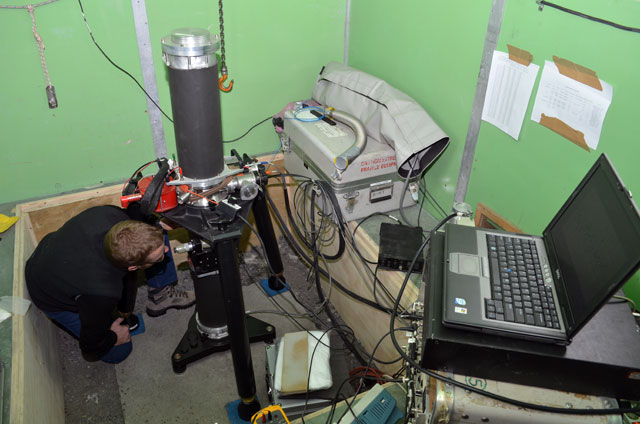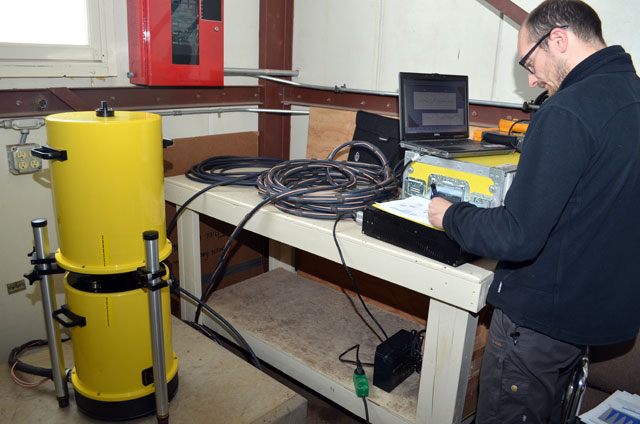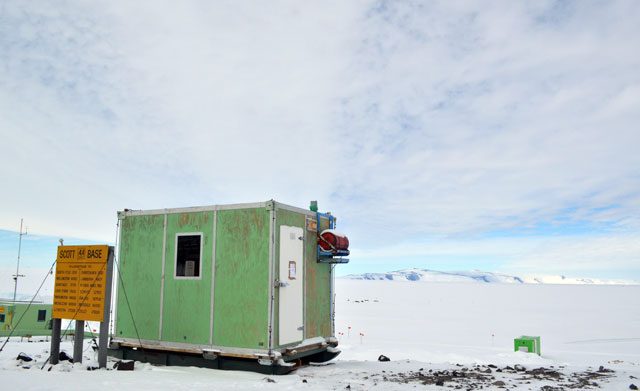|
Page 2/3 - Posted March 9, 2012
That’s heavyScientists aren’t relying solely on space-based measurements of gravity. POLENET researchers are collaborating with French and Danish scientists who use ground-based instruments to measure gravitational changes over relatively small areas compared to the larger footprints covered by the satellites. “It’s partly ground-truth for GRACE. It’s also an independent way of measuring uplift and mantle flow that’s related to rebound,” Wilson said. The absolute gravity measurements are also important to separating the signals between the long-term post-glacial effect and the short-term “elastic” response of the earth from modern ice loss, according to Yves Rogister, an assistant professor at the University of Strasbourg 
Photo Credit: Peter Rejcek
French scientist Jean-Daniel Bernard works on the FG5 absolute gravimeter in a shelter at Scott Base.
“The GPS and gravity measurements are complementary,” he said. Rogister and colleague Jean-Daniel Bernard brought down what’s called an FG5 absolute gravimeter, which looks a bit like a camera tripod on steroids, to McMurdo Station Think about Italian scientist Galileo Galilei’s famous gravity experiment of dropping two balls of differing weights from the Tower of Pisa to get an idea of how the gravimeter works. A vacuum is created in an upper chamber in which an object repeatedly free falls over a period of time. The acceleration of the object, measured using a laser interferometer and an atomic clock, is related to the pull of gravity, or the mass, of the earth below the site. By comparing this year’s measurements against those made two years ago, the scientists should be able to detect a subtle change in mass. “We have the same value as two years ago, which means that gravity isn’t changing here much,” Rogister said of the preliminary data around Ross Island. A little lighterUnfortunately, the FG5’s extreme sensitivity makes it less than an ideal field instrument. The French scientists are limited to doing the experiment in established shelters at research stations like McMurdo, New Zealand’s nearby Scott Base A more portable version of the instrument brought to the Ice from Denmark isn’t so limited, according to Larry Hothem, a scientist from the U.S. Geological Survey “It’s not as accurate, but it’s not as sensitive,” he said. Jens Emil Nielsen Nielsen made a number of trips aboard either a helicopter or Twin Otter with the A10 to ANET sites accessed from McMurdo Station to test how the instrument would handle field conditions. If deemed successful, it will be flown to ANET sites in West Antarctica next year. Ideally, each deployment should take about three hours. “It’s supposed to be a hit and run,” Nielsen said. The abbreviated measurements allow more “noise” from tides and other disturbances in the A10 data, which means there’s more work for the scientists using the portable gravimeter on the back end of the study. “These effects are not eliminated by the measurements,” Nielsen noted. “In that case, you have to do some extra processing.”Back 1 2 3 Next |



For USAP Participants |
For The Public |
For Researchers and EducatorsContact UsU.S. National Science FoundationOffice of Polar Programs Geosciences Directorate 2415 Eisenhower Avenue, Suite W7100 Alexandria, VA 22314 Sign up for the NSF Office of Polar Programs newsletter and events. Feedback Form |



